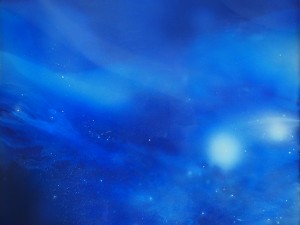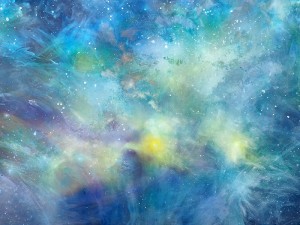A Spacetime Odyssey – For Einstein
Chak Chun Lam
Acrylic on aluminium panel
120cm x 60cm
2016
時空之旅 – 向愛恩斯坦致敬
翟震霖
鋁板丙稀
120釐米 x 60釐米
2016
About this painting
What is space and time? This is one of the fundamental questions that human has been asking since the dawn of civilization. One hundred years ago, Albert Einstein, one of the greatest scientists of the 20th century, wrote down the mind-boggling equation of general relativity. Space can be curved and time can be slowed down in the presence of matter and energy. After one hundred years, all the predictions of general relativity are confirmed by experiments, including gravitational wave which was just discovered by LIGO (Laser Interferometer Gravitational-Wave Observatory) in 2016. Gravitational wave is the ripple of space-time itself, created by the motion of massive objects such as black holes and neutron stars. About 400 years ago, Galileo first turned his telescope into the sky to look at Jupiter and its moon which started the field of modern astronomy by using telescopes. We have been using telescopes to look at the light and electromagnetic waves of stars and galaxies ever since. Now, the discovery of gravitational wave opens up a whole new way for us to look at the universe and allow us to discover more about exotic phenomena such as black holes, neutron stars and perhaps the Big Bang.
關於這幅畫
甚麼是時間和空間? 人類自有文明以來已經提出這個問題。一百年前,二十世紀最偉大的科學家愛恩斯坦寫下廣義相對論的方程式,從此改寫人類對宇宙的認識。質量和能量竟然可以令時空扭曲,時間和空間不再是靜止的。一百年後,廣義相對論依然歷久如新,所預測的現象也被實驗一一驗證,包括由 雷射干涉重力波天文台(LIGO) 於2016年最新發現的重力波(Gravitational Wave) 。重力波是由巨大質量天體的高速運動扭曲時空所引發的”漣漪”。四百年前,伽俐略把他的望遠鏡轉向天空觀察木星和它的衛星,開啟了天文學的新領域,自此我們利用望遠鏡觀察天體所發出的光和電磁波來認識宇宙。現在,重力波的發現正式開啟了重力波天文學,我們可透過觀察重力波來認識一些極端的天文現象,包括黑洞、中子星甚至大霹靂。



